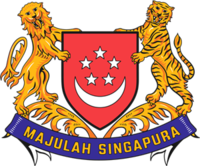| Coat of arms of Singapore | |
|---|---|
 | |
| Armiger | Republic of Singapore |
| Adopted | 3 December 1959 |
| Shield | Gules, a crescent facing a pentagon of five mullets argent |
| Supporters | A lion dexter and a tiger sinister rampant guardant standing on two branches or |
| Motto | Majulah Singapura (English: "Onward Singapore") |
| Earlier version(s) | See Armorial of Singapore |
| Use | Reverse of coins, government buildings, Acts of Parliament, commissions and treaties |
The coat of arms of Singapore is the heraldic symbol representing the sovereign island country and city-state of Singapore located in maritime Southeast Asia. It was adopted in 1959, the year Singapore attained self-governance from the British Empire, and remains in use after its independence in 1965. The committee that created it, headed by Toh Chin Chye, who was also responsible for the national flag and the national anthem of Singapore.
At the centre of the emblem is a red shield bearing a white crescent, a new moon—representing a "young nation on the ascendant", and five white stars—representing democracy, peace, progress, justice and equality, supported by a lion and a tiger—representing Singapore's namesake and the country's historical ties to the Malay Peninsula; below them is a blue ribbon inscribed with Majulah Singapura in gold, Malay for "Onward Singapore".
While the use of the coat of arms is restricted to the government, the symbol enjoys wide use on the national currency and state decorations, and appears on the cover of the national passport.